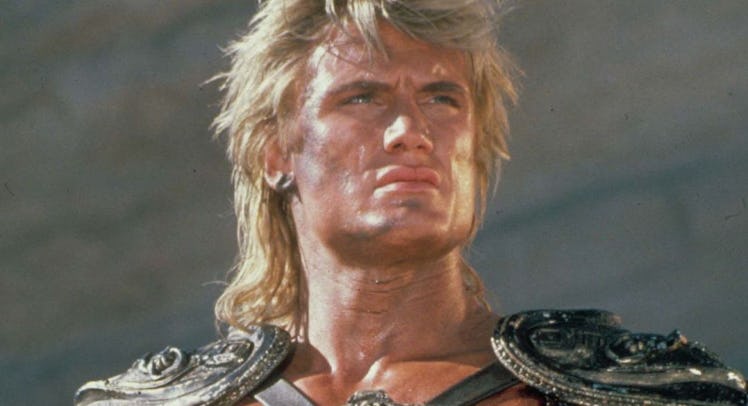‘He-Man and the Masters of the Universe’ Was Way Smarter Than We Thought
Eighties kids had it real good.

There’s a great scene in Ghostbusters II which encapsulates how He-Man ruled the 1980s and the minds of American boys. With no ghosts to bust, and in need of cash, Ray (Dan Aykroyd) and Winston (Ernie Hudson) do a paid appearance at a kid’s birthday party. But when they try out the famous Ghostbusters call-and-response “who you gonna call?” all the kids yell back “He-Man! He-Man! He-Man!” In the eighties, He-Man ruled kid’s TV and the toy world, too. But modern guys in their thirties and forties may feel uncomfortable respecting their old muscle-bound pal; professing love for Star Wars and the Transformers is acceptable, but He-Man? That was a joke, right?
Turns out, our shared love of He-Man was justified, and that’s because both the toys and the cartoon series were groundbreaking, and much more intelligent and morally complicated than anyone ever realized. In August of this year, Netflix released a documentary called The Power of Grayskull: The Definitive History of He-Man and the Masters of the Universe. And though the documentary proves He-Man was a cash-grab, it was a cash-grab with a strange amount of heart. Cynicism it seems has no place when looking back at the planet of Eternia.
Filmation
Despite being a macho, muscular badass in the vein of Conan the Barbarian, He-Man the character actually had a moral compass less like a savage and more like an honorable knight. Early in the documentary, we learn that the creators wanted He-Man to look like a guy in a bar who could beat the shit out of everyone, but with the spirit of “Galahad,” one of the legendary Knights of the Round Table. In the original eighties Filmation TV show, each episode of He-Man (and later She-Ra) ended with a coda in which children were told exactly what the moral lesson was in the episode they just watched. In the documentary, the writers of the show complain about the ham-handedness of these segments, but in a sense, those codas are part of what made the show what they were. As a child, I often looked forward to that part of the show, because it made me feel like the momentum of the episode could stay with me even though the show was over. And, it turns out the idea of empowering children was integral to the design Masters of the Universe from the onset.
In the documentary, one of the original writers of He-Man and the Masters of the Universe, J. Michael Straczynski (Sense8, Thor, Babylon 5) elucidates this concept clearly: “When He-Man said ‘I Have the Power!’ it was saying to kids, you have the power. You don’t have to do what your parents say anymore. Being transformed into your inner, true self is very attractive.”
Another writer for the show, David Wise, doubles-down on this idea saying that Masters of the Universe was intentionally written “above their level [kids] and on their level at the same time.” And when you think about some of the deeper ruminations the film version of Masters of the Universe would explore, this becomes completely true. “Tell me about the loneliness of good, He-Man. Is it equal to the loneliness of evil?” Frank Langella (Skeletor) says in the film. Yep. Bet you forgot a great line like that was in this movie! But, what makes it even better is that this line — and most of Skeletor’s dialogue in the film — was written by Langella himself, while the actor was researching Joseph Campbell books. The point is, behind these cheesy thrones and swords lurked thoughtfulness, intelligence, and heart.
Though swordplay and violence are central to the story of He-Man, the narratives are anti-violence. This fact is so true, that Dolph Lundgren (He-Man) admitted that Masters of the Universe was one of the only films he did that he could show to his children comfortably. And though the film version of He-Man was directed by a man (Gary Goddard) the TV series was directed by a woman; Gwen Wetzler oversaw the original Filmation run of the cartoon. This fact doesn’t prove He-Man was somehow woke, but it does prove there was more care and diverse opinions injected into its creation than one might assume. In watching The Power of Grayskull, you will learn that yes, though several white guys may have invented He-Man, he was nurtured and made into a hero by a team populated of people of color and women.
More importantly though, what was special about He-Man was fantasy world he unlocked for children. By combining his sword with Skeletor’s, He-Man could open the drawbridge of Castle Grayskull. This fact is interesting because it’s complicated and suggested to children that long-term goals would require planning, bravery, and eventually, compromise. There never was a definitive end to the story of He-Man and the other Masters of the Universe. And that’s because, for many of us who grew up with it, the story just kept going, locked away somewhere in our imaginations.
Now, if you’ll excuse me, I’m going to go look for the other half of this sword.
The Power of Grayskull is streaming on Netflix right here.
This article was originally published on